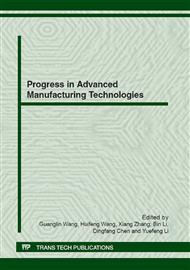p.92
p.97
p.103
p.110
p.117
p.123
p.127
p.132
p.136
Fabrication of 3D Hierarchical Scaffolds by a Hybrid Process Combining Low-Temperature Deposition and Electrospinning
Abstract:
An ideal scaffold should mimic the morphology of the natural extracellular matrix and have good mechanical properties and biologically functional. So, the key point of fabricating of scaffolds is to realize the composition of scaffolds by materials having different physical and biological properties and control porous structure accurately. In this study, we propose a novel technology combining a low-temperature deposition, electrospinning process and freeze-drying to produce a hierarchical 3D biomedical scaffold consisting of micro-sized highly porous chitosan-gelatin strands and nanosized PCL fibers network. Scanning electron microscopy analysis showed that the scaffold composed of parallel aligned micro-strands in a grid-like arrangement layer by layer, along the thickness direction intercalated by a network with randomly distributed nanofibers. The stand of macro-scaffold composed of natural-derived biomaterials and nanofibers composed of synthetic biomaterials were bonded together firmly to form a stable network structure.
Info:
Periodical:
Pages:
117-122
Citation:
Online since:
August 2012
Authors:
Price:
Сopyright:
© 2012 Trans Tech Publications Ltd. All Rights Reserved
Share:
Citation:


